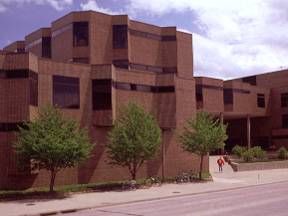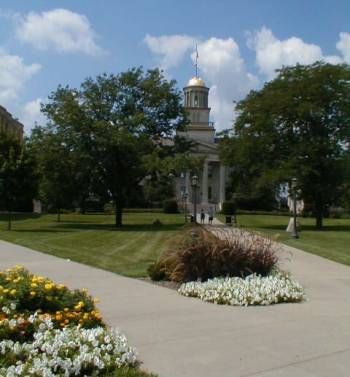|
Day 1 |
Probing America: High Tech on Back Roads Day Eight South Sioux City, Nebraska, to Iowa City, Iowa July 1, 1992 This has been a day of cognitive dissonance for one member of the group who drove out of Iowa City a few weeks short of 34 years ago. The Iowa River is about the only thing that seems in place, and they built a foot bridge over it. The old college of education and department of psychology are now somehow fused in a single building known as Seashore. It dates a person to know that Seashore was an early 1900s psychologist who among other things was interested in psychological aspects of music, and who developed the Seashore Musical Aptitude Test. It didn't amount too much, after all, but still how many of us have a college building named in our honor.
The faculty of Education, Iowa Testing Center, and the A Computing Center are all housed in the Lindquist center. E.F. Lindquist was a leading light in the design of educational research and educational development testing. One team member had a course from him, which made sense only when he learned that the great professor's degree was in English, or was it humanities. Lindquist did very well financially. He developed highly popular (well, among the test givers, at least) nationally used achievement tests while at the University of Iowa, but believed it was unethical to copyright them in his name (he also probably knew that the University would sue him if he did). An imaginative fellow, he did what had not occurred to anyone else. He registered a copyright on the mark sense answer sheets of the test. The royalty percentage was very small, but when multiplied by the number of hundreds of thousands of elementary and high school kids who took the test each year, he did well, to say the least.
About the time of his retirement plans were announced for the Lindquist Center. It is not an appendage of the former college of education, but a new building standing near the banks of the Iowa River, across from the medical school complex. It must be twenty years old, or nearly that, and already looks very shop worn, as only students can shop wear a facility. The design is a collection of eight sided components, grouped in four stacks, three stories high. Each component houses a division of the college or other units as noted. The architect's intent was to promote collegiality, which was what the faculties undoubtedly said they wanted. The result, obviously, is complete isolation by "disciplines" which is probably what they really wanted. Which is not all bad, because that is in the tradition of many academics. Keep it separate, don't mix it up or confuse me with other views of truth.
Life goes on nicely in Iowa City. They had their Lindquist and more splashy Van Allen and his belt, the sports complex grows each year, outrageous college costumes arrive 2 or 3 years after hitting both coasts (there are still signs of hippiness in Iowa City). The relative cultural isolation is comforting. If only Iowa City were closer to the sea and mountains, it would be as attractive as Eugene or Corvallis, also culturally isolated. But it is not. Alright! Thomas Wolfe said it first. |



